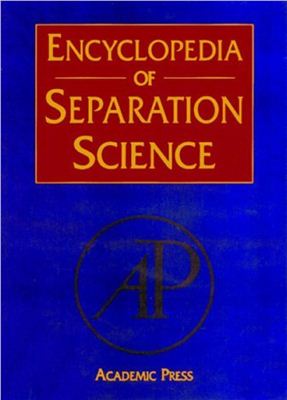Academic Press, UK, 2000 - 4927 p.
Michael Cooke, Colin F. Poole - editors
Ian D. Wilson - editor-in-chief
Edward R. Adlard - managing technical editor
Basically, all separation techniques rely on thermodynamic differences between components to discriminate one component from another, while kinetic factors determine the speed at which separation can be achieved. This applies most obviously to distillation, chromatography and electrophoresis, but is also obvious in most of the other techniques; even particle size separation by sieving can be classiRed in this way. The thermodynamic aspect is, of course, trivial being represented by the different sizes of the particles, as indeed it is for the size exclusion chromatography of polymers. However, the kinetic aspects are far from trivial. Anyone who has tried to sieve particles will have asked the question: is it better to Rll the sieve nearly to
the top and sieve for a long time, or is it better to dribble the material slowly into the sieve and just remove the heavies from time to time? One might further ask: how does one devise a continuous sieving process where large particles emerge from one port of the equipment, and small ones emerge from the other port? And how does one optimize throughput and minimize unit cost?
The publication of this Encyclopedia of Separation Science is a landmark for this area of science at the start of the third millennium. It will undoubtedly be of enormous value to practitioners of separation science looking for an overview and for guidance as to which method to select for a new problem, as well as to those who are at an early stage, simply dipping their toes into the waters, and trying to Rnd out just what it is all about.
Michael Cooke, Colin F. Poole - editors
Ian D. Wilson - editor-in-chief
Edward R. Adlard - managing technical editor
Basically, all separation techniques rely on thermodynamic differences between components to discriminate one component from another, while kinetic factors determine the speed at which separation can be achieved. This applies most obviously to distillation, chromatography and electrophoresis, but is also obvious in most of the other techniques; even particle size separation by sieving can be classiRed in this way. The thermodynamic aspect is, of course, trivial being represented by the different sizes of the particles, as indeed it is for the size exclusion chromatography of polymers. However, the kinetic aspects are far from trivial. Anyone who has tried to sieve particles will have asked the question: is it better to Rll the sieve nearly to
the top and sieve for a long time, or is it better to dribble the material slowly into the sieve and just remove the heavies from time to time? One might further ask: how does one devise a continuous sieving process where large particles emerge from one port of the equipment, and small ones emerge from the other port? And how does one optimize throughput and minimize unit cost?
The publication of this Encyclopedia of Separation Science is a landmark for this area of science at the start of the third millennium. It will undoubtedly be of enormous value to practitioners of separation science looking for an overview and for guidance as to which method to select for a new problem, as well as to those who are at an early stage, simply dipping their toes into the waters, and trying to Rnd out just what it is all about.

